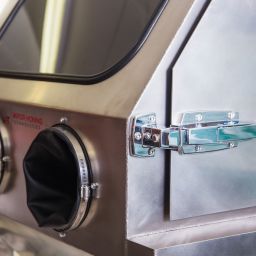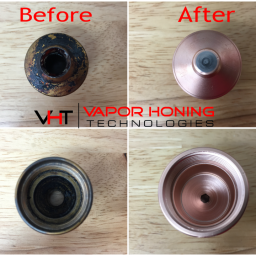What Are the Types of Blasting?
Abrasive blasting is a huge industry and there are many different types of blasting, with the market size for blasting media projected to exceed a mind-boggling $12 billion in 2025. Increasing demand for abrasive blasting in the metalworking and construction sectors will continue to spur the growth of the industry for the foreseeable future.
Abrasive blasting goes by several other names, including media blasting and grit blasting. It’s a popular surface cleaning and preparation method that’s effective for just about any surface.
Based on the abrasive media used, there are many types of blasting you can choose from. Each type of blasting fits the specific surface modification you’re looking for.
But what exactly is abrasive blasting? What types of abrasive blasting are there? How can you maximize the benefits of this procedure?
If you’re asking yourself these questions, you’ve come to the right place. In this comprehensive guide, we tell you all you need to know about blasting.
Read on to learn more.
What Is Abrasive Blasting?
In abrasive blasting, an abrasive material is propelled at extreme velocities to smooth-en, clean, or shape a surface.
Typically, pressurized fluid or a centrifugal wheel propels the blasting material. Abrasive blasting has been around since the late 19th century.
Is Blasting Necessary?
Is the cost of investing in blasting equipment or hiring an abrasive blasting service provider justifiable? The simple answer is yes. Here are three top ways abrasive blasting helps in your metalwork or construction projects.
It Helps Prepare the Surface
The primary purpose of abrasive blasting is to smooth out surfaces. This is especially essential when you intend to paint the exterior of your metal or steel building.
Blasting helps remove dirt and chemicals that might make it harder for the paint to adhere to the surface. Blasting also removes lines and bumps once you’ve finished painting the surface.
Blasting Removes Rust and Corrosion
Metal and steel experience rust and corrosion with time. The result is an unappealing appearance. You need to deal with the situation to restore the structure’s visual appeal.
Removing rust and corrosion effectively requires using appropriate products and processes. With the right blasting equipment and media, you can efficiently and effectively tackle corrosion on your metal surfaces.
It Boosts Paint Longevity
Paint manufacturers generally recommend applying paint on a properly prepared surface. This helps increase the paint’s longevity. Abrasive blasting takes care of any bumps, rust, and old paint that might get in the way of a smooth surface.
This way, there will be fewer paint streaks and cracks that would shorten your paint’s lifespan.
Types of Blasting
Abrasive blasting comes in many variants, based primarily on the media used. Some types of blasting are highly abrasive, while others are comparatively milder. Let’s look at each type of blasting more closely.
Sandblasting
Sandblasting is arguably the most popular type of abrasive blasting. So well known is this process that it’s the term sandblasting is sometimes used interchangeably with abrasive blasting.
In sandblasting, silica or quartz is the abrasive material (media). The media is propelled at high speed onto the surface you’re preparing. The abrasive material’s sharpness and consistency in size make sandblasting effective in giving a uniform finish.
Sandblasting is especially effective in removing rust and corrosion from metal surfaces.
In sandblasting, the blasting equipment uses air pressure for firing dry abrasive particles. Media comes out of the equipment through a hand-held nozzle.
In most cases, sandblasting operation happens in an open-space environment. Professionals need to adhere to certain environmental regulations that control where sandblasting can be performed. The silica used in this type of blasting can be hazardous to health, so adherence to safety precautions is important.
Vapor Honing/ Wet Blasting
You’re probably familiar with the vapor honing vs. sandblasting discussion. The discussion seeks to establish which of the two blasting processes is best for you.
The truth is wet blasting solves some of the problems associated with sandblasting. For instance, sandblasting results in a massive amount of airborne dust that may be harmful to your health when inhaled.
The vapor honing process starts in a similar manner to sandblasting. The abrasive material is mixed with water to form a slurry. After this step, the two technologies start to differ.
In wet blasting, you mix the slurry into a liquid in a wet blast machine before pumping it into the blasting gun. Once there, pressurized air propels the mixture onto the surface. The flow of the mixture smooths away corrosion, leaving behind a smooth finish.
Compared to sandblasting, vapor blasting is a much gentler process both on the person doing the job and the surface being prepared. What makes the process easier on your body is that it doesn’t involve chemicals and harsh dust. For the surface being prepared, vapor honing cleans by flow instead of harsh impact.
Currently, it’s easy to get vapor honing cabinets on the market, but which machine fits best for your application.
And while vapor honing machines may seem pricey. However, the many benefits of this procedure should make up for these upfront costs relatively quickly.
Vacuum Blasting
Also known as dustless blasting, vacuum blasting uses a blasting machine equipped with vacuum suction to remove propelled abrasives and surface contaminants. The materials are then instantly sucked back into the equipment’s control unit.
One of the top benefits of vacuum blasting is that the process is highly effective in recycling spent abrasives. That makes this blasting process highly cost-efficient. Besides, dustless blasting minimizes the need for cleaning debris during and after the blasting process.
The main drawback of vacuum blasting is that it’s a bit slower than other blasting methods. That’s primarily because of the recycling function.
Vacuum blasting is ideal for abrasive processes that require minimal debris creepage into the environment.
Centrifugal Blasting
Centrifugal blasting is sometimes referred to as wheel blasting. In this type of blasting, a motor-operated blade wheel hurls abrasive material at high speed towards a surface that needs cleaning.
What makes centrifugal blasting so popular is its ability to clean large surfaces fast. Moreover, this blasting technique does not require compressed air to operate, which increases its cost-effectiveness.
The abrasives used in this technique are also recyclable. Typically, the debris is collected by the machine’s collector unit, reducing the need for cleaning the area after the blasting process.
Perhaps the main drawback with wheel blasting is that the machine used is much larger and, thus, less portable. Operating the equipment on uneven surfaces is also a challenge.
Soda Blasting
Soda blasting is one of the newer forms of blasting available today. This type of blasting uses sodium bicarbonate as an abrasive material. Air pressure blasts the material on the surface you’re cleaning.
Sodium carbonate is highly effective when it comes to removing contaminants from surfaces. Upon impact with the surface, the abrasive shatters and exerts force, clearing up contaminants from the surface.
Soda blasting is a gentler form of blasting compared to most other blasting techniques. The pressure exertion required is much less, which makes this technique ideal for soft or fragile surfaces such as plastic, glass, and chrome.
The main drawback of this technique is that it doesn’t allow recycling of the abrasive material.
Steel Grit blasting
In steel grit blasting, spherical steels are the abrasives. This blasting technique is especially common in the cleaning of metal surfaces. Using steel grit blasting, you can easily rid surfaces of old paint, rust, and corrosion.
Added benefits of steel grit blasting include the fact that surfaces end up smoother than when cleaned with most other blasting methods. Besides, this blasting method helps in peening, which enhances the strength of the metal.
Other than spherical steels, you can use such materials as silicon carbide (SiC), aluminum, and walnut shells. The material you choose depends on the surface you intend to clean.
Bristle Blasting
Unlike other blasting techniques, bristle blasting doesn’t involve the projection of abrasive material onto surfaces to clean them. Instead, you rotate steel wire bristles against the surface you’re cleaning to remove contaminants. The result is a smooth, uniform surface.
One of the reasons bristle blasting is so popular is its simplicity. This technique makes surface preparation a straightforward affair that DIY enthusiasts can enjoy. Bristle blasting also drastically cuts expenses by eliminating the need for costly blasting equipment, media, and too many environmental and safety measures.
Dry-ice blasting
Dry-ice blasting is a more recent and more innovative form of abrasive blasting. It uses air pressure and carbon dioxide pellets for cleaning surfaces. The carbon dioxide pellets used in this blasting technique are created by freezing liquid carbon dioxide at extreme temperatures.
The pellets take the appearance of snow. When these pellets impact the surface you’re cleaning at high velocity, their extremely low temperature coupled with their sudden impact on the surface creates thermal shock. The shock helps break bonds between the contaminant and the surface, dislodging the unwanted material from the surface.
Dry-ice blasting has many benefits, including the ability to clean surfaces incredibly quickly.
The carbon dioxide used is non-toxic and doesn’t react at all with any contaminants on the surface you’re cleaning. For this reason, dry-ice blasting is the better choice when cleaning the surfaces of food processing equipment.
Another benefit is that there’s no abrasive material that you need to clean up or recycle. Moreover, the carbon dioxide pellets you use are non-reactive and eco-friendly.
No damage results from the cleaning process. Therefore, dry-ice blasting technique is perfect for sensitive electrical components.
Pencil Blasting
Also known as micro-blasting, pencil blasting is an abrasive blasting technique where you mix fine powder with high-pressure air and then ejected out as an abrasive. This abrasive comes out through a small nozzle, creating a fine, highly precise stream, hence the name.
Pencil blasting is effective in cleaning specific areas of a surface. The nozzle’s small size makes it easy to adjust the machine to do other tasks besides blasting. For instance, you can program the machine to drill, cut, or deburr a surface.
Pencil blasting is sometimes used in glass etching as well as in altering the surfaces of diamonds.
The biggest benefit of pencil blasting is its astonishing precision.
Bead Blasting
As the name suggested, bead blasting uses glass beads to prepare surfaces. Pressurized air ejects the beads from the blasting equipment. The beads have a spherical shape and create micro dimples when they impact the surface you’re cleaning.
Bead blasting is highly effective when it comes to cleaning, peening, and deburring metal surfaces.
Bead blasting results in a highly uniform finish. The glass beads are entirely recyclable, which makes this blasting technique highly cost-effective. Moreover, bead blasting is non-toxic and eco-friendly.
Maximizing Blasting Results
Let’s look at a few things you can do to reap the maximum benefits of this procedure.
The first thing you need to do is follow safety precautions, depending on the blasting method you’re using. For instance, sandblasting involves abrasive particles flying through the air at incredible speeds. These particles can hurt your skin upon impact, which is why you need to cover exposed skin when doing the project.
Ensure you’re using the right type of particles for the job. The wrong media will not only do a poor job at cleaning the surface but could also damage it. That’s why it’s always advisable to use professional blasting services as they know what they’re doing.
Determine the Ideal Blasting Technique for Your Project
As you’ve seen, there are many different types of blasting to choose from when cleaning a surface. Not all blasting techniques are suitable for every surface. Take the time to determine what blasting approach and media will have the best results for your project.
Are you interested in reliable blasting equipment? Please, contact us today.








